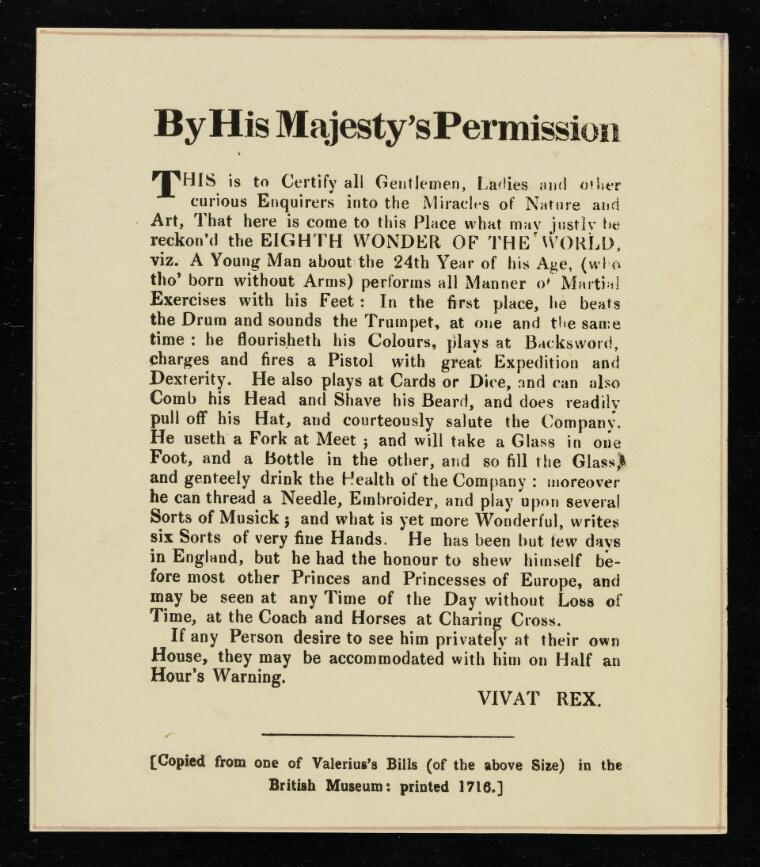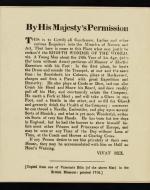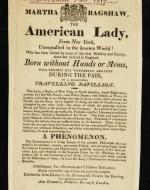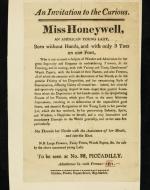Created by Ashley Burgoon on Mon, 05/02/2022 - 11:03
Description:
In the Victorian era, a new form of entertainment became increasingly popular. People from all over would pay to gain entrance into these “freak shows,” where individuals with a variety of different disabilities performed. One disability, in particular, drew people in. Individuals who were born without certain limbs like arms, hands, feet, and even heads became a spectacle, their disabilities being exploited all for profit. These seemingly “normal” tasks wouldn’t be exciting to watch today, so, why would able-bodied people pay money to watch these individuals perform tasks that many of them were already performing on a daily basis? The truth is a lot of the able-bodied people that watched this portion of the show actually viewed the performers as strong for overcoming their disabilities. In this case, despite the exploitation, the performers were not being put down by the spectators. The “freak shows” allowed able-bodied people to view those with disabilities in a positive light, performing tasks that they, the able-bodied people, would perform normally.
[Leaflet advertising performances by a man with no arms at the Coach and Horses at Charing Cross. from one of valerius's bills originally printed in 1716].. Public Domain Mark
Nicknamed “The Eighth Wonder of The World,” this man, who was born without arms, can perform tasks like playing the drum and trumpet, firing a pistol, playing cards, and dice, etc. A lot of these tasks prove that he is capable of being a part of society. The society that he was born into wouldn’t have been accepting of him before. The mini “freak shows” allowed able-bodied people to observe people with disabilities performing tasks that they would do normally, this opens up the opportunity to view disabled people in a new light. The disabled person is proving that having a disability shouldn’t be viewed as a disadvantage because they can still do things that “normal” people would do, that is why some of the tasks seem weird. Why would someone want to watch another person shave his beard or serve wine? Simply because the people at the time didn’t think it was possible to do those things without hands or arms. Thanks to the disabled person, the able-bodied people have now been shown proof that, just because someone has a disability, they aren’t inherently weak or at a disadvantage.
[Leaflet advertising appearances by Herr Unthan, "the armless wonder" at theSouth London Palace, 15 April (1889?). Printed on pink paper].. Public Domain Mark
Carl Herrman Unthan, nicknamed “The Armless Wonder,” became famous for his ability to play the violin with his feet. There is little information on his childhood, however, it has been claimed that his father was one of the reasons that he learned to play the violin. His father was quite strict with him and this caused Unthan to learn how to do “normal” tasks with his feet. As the picture states, Unthan can play cards, shake hands with you, offer you a glass of wine, make you a cigarette, etc. At the beginning of his career, Unthan would do those tasks that seemed less human and more show-off material. However, he learned to play the violin and this changed his career forever. Again, he has a chance to show able-bodied people that having a disability certainly doesn’t mean you can no longer live a meaningful life. Sure, he spent a lot of time performing tasks for other people. However, he also spent a lot of time playing the violin and making a name for himself. Sympathy can lead to a better acceptance of difference. Watching people as Unthan perform makes it easier to accept people with disabilities into society, this is because the able-bodied people see that they aren’t very different from the person with the disability.
[Leaflet advertising appearances by Martha Bagshaw, the American lady born without hands or arms (Bartholomew Fair 1817?). ].. Public Domain Mark
Despite being born without hands or arms, Martha Bagshaw was able to overcome the difficulties of her disability. She is able to work Embroidery and perform tasks such as cutting Watch paper with initials or any design that is given to her, writing, drawing, threading a needle, and even tying the knot. She does all of this using only her mouth and toes. Instead of painting Bagshaw in a negative light, the author of the excerpt has nothing but positive things to say about her. In fact, this article has a rather positive overall viewpoint considering the connection with “freak shows.” The author says, “Those aquirements she now possesses have been attained by her own natural vigor of mind, without any scholastic Education, and whilst contemplating these united qualifications, all must acknowledge her a phenomenon.” Bagshaw is, indeed, an impressive woman. The author recognized the hardships that Bagshaw had to face and, instead of labeling her a “freak” and casting her away as an “other,” they gave her an opportunity to be empowered by her disability, while also displaying this message to the able-bodied people who paid to watch her perform. Overall, the message is empowering for both sides.
[Leaflet advertising appearances by Miss Honeywell, an American lady born without hands, at 32 Piccadilly, London (1811?)].. Public Domain Mark
In this picture, we meet a lady by the name of Miss Honeywell. She was born without hands and only has three toes on one foot. Despite her disability taking most of the admiration away from the tasks that she performs, Miss Honeywell’s “cheerful and sportively engaging aspect at once dispel those painful sensations which the deprivation of her limbs excite in the sympathizing breasts of her visitors.” Even so, there is still a good message hidden within this sympathy that she receives. Yes, you could look at the sympathy as a sad reminder that she will never be “normal.” However, the spectators are still learning while viewing what she does. Just like Bagshaw, the viewers are able to see that there is hope that you can still live a fulfilling life with a disability, especially the loss of a limb. Miss Honeywell is able to thread a needle with her mouth and tie the knot. Even though the loss of a limb may seem scary, she is proving that it shouldn’t stop you from living your life. She is also sending a positive message to women.





